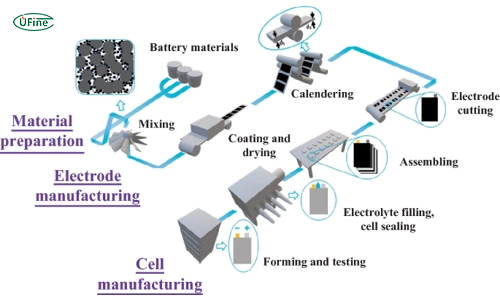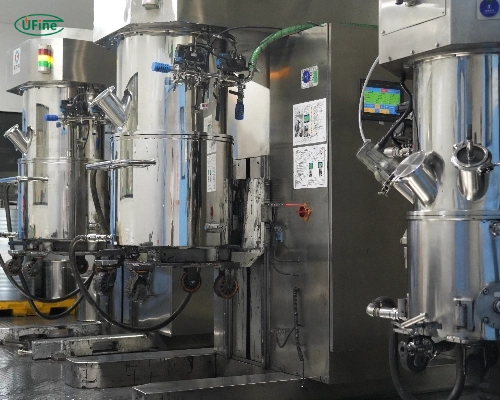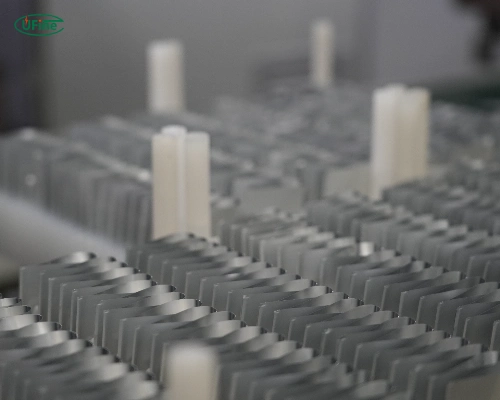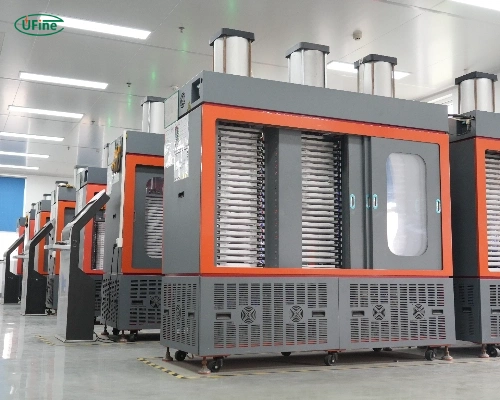The battery manufacturing process is a complex sequence of steps transforming raw materials into functional, reliable energy storage units. This guide covers the entire process, from material selection to the final product’s assembly and testing. Whether you’re a professional in the field or an enthusiast, this deep dive will provide valuable insights into the world of battery production.
Part 1. Battery raw material selection
The foundation of any battery is its raw materials. These materials’ quality and properties significantly impact the final product’s performance and longevity. Typical raw materials include:
- Lithium: Lithium-ion batteries are known for their high energy density and efficiency due to their use in them.
- Nickel: Essential for nickel-metal hydride (NiMH) and nickel-cadmium (NiCd) batteries.
- Cobalt: Enhances energy density and stability in lithium-ion batteries.
- Graphite: Serves as the anode material in lithium-ion batteries.
Part 2. Battery electrode production
2.1 Cathode Manufacturing
The cathode is a critical battery component in determining its overall capacity and voltage. The cathode production process involves:
- Mixing: Mix conductive additives and binders with raw materials like lithium cobalt oxide (LiCoO2) or lithium iron phosphate (LiFePO4).
- Coating: The mixture is coated onto a metal foil, typically aluminum, forming a thin layer.
- Drying: The coated foil is dried to remove solvents, ensuring a stable and uniform cathode layer.
- Calendering: Press the dried cathode to achieve the desired thickness and density.
2.2 Anode Manufacturing
The anode is equally crucial, impacting the battery’s charge-discharge efficiency. Anode production steps include:
- Mixing: Combine graphite with conductive agents and binders.
- Coating: The mixture is applied to a copper foil, creating a uniform layer.
- Drying: Drying the anode, like the cathode, helps eliminate solvents.
- Calendering: Press the dried anode to achieve optimal thickness.
Part 3. Battery electrolyte preparation
The electrolyte facilitates ion movement between the cathode and anode, which is essential for the battery’s operation. Electrolyte preparation involves:
- Solvent Selection: Choosing a solvent that ensures good ionic conductivity and stability.
- Salt Dissolution: Dissolving lithium salts (e.g., LiPF6) in the solvent creates the electrolyte solution.
- Additive Integration: Adding stabilizers and performance enhancers to improve battery life and safety.
Part 4. Battery cell assembly
4.1 Winding or Stacking
The next step is assembling the battery cells. There are two primary methods:
- Winding: The anode and cathode foils, separated by a porous film, are wound into a jelly-roll configuration.
- Stacking: Stack the anode, separator, and cathode layers in a flat, layered structure.
4.2 Cell Enclosure
After winding or stacking, enclose the cells in a casing, which can be cylindrical, prismatic, or pouch-style. This casing protects the internal components and ensures structural integrity.
Part 5. Battery electrolyte filling process
The electrolyte filling process is one of the most critical stages in battery manufacturing, as it directly influences the battery’s performance and safety. This step involves introducing the electrolyte into the cell and ensuring it saturates the electrodes correctly. Here’s a detailed look at the process:
5.1 Vacuum Filling
The cells are placed in a vacuum chamber to ensure the electrolyte fills all the pores of the electrode materials. The vacuum removes any air and moisture from the cell, creating a void the electrolyte can fill. This step is crucial for achieving uniform distribution and preventing air pockets that could impair performance.
5.2 Electrolyte Injection
The electrolyte is injected into the casing once the cells are vacuumed. Meticulously control this process to ensure the exact amount of electrolytes are added. Too little electrolyte can lead to poor conductivity and reduced capacity. At the same time, too much can cause leakage and potential safety hazards.
5.3 Soaking and Wetting
After injection, the cells undergo a soaking period, allowing the electrolyte to permeate the electrodes fully. This process, known as wetting, ensures that the electrolyte penetrates the micropores of the electrodes, facilitating efficient ion transport. This step may take several hours to days, depending on the battery type and the materials used.
5.4 Sealing
Seal the battery cell once the electrolyte has fully saturated the electrodes. This is a critical step to prevent the electrolyte from evaporating or leaking. Sealing must be airtight and robust to ensure long-term stability and safety, with pouch cells commonly using heat sealing. In contrast, cylindrical and prismatic cells use crimping or welding techniques.
5.5 Initial Charge (Formation)
After sealing, the cells undergo an initial charge, also known as formation. This involves slowly charging the battery for the first time, which helps form a stable Solid Electrolyte Interphase (SEI) layer on the anode. The SEI layer is crucial as it protects the anode from reacting with the electrolyte, thus enhancing battery life and performance. The formation is typically done under controlled conditions to monitor and optimize the electrochemical properties of the battery.
Part 6. Battery formation and conditioning
6.1 Formation
The formation process involves the battery’s initial charging and discharging cycles. This step helps form the solid electrolyte interphase (SEI) layer, which is crucial for battery stability and longevity. During formation, carefully monitor the battery’s electrochemical properties to meet the required specifications.
6.2 Conditioning
After formation, the batteries undergo conditioning, which includes additional charge-discharge cycles to stabilize performance and ensure uniformity across cells. Conditioning helps identify early-stage failures and ensures that only high-quality cells proceed to the next stage.
Part 7. Battery module and pack assembly
Individual cells are then grouped into modules and assembled into battery packs. This step involves:
- Module Assembly: Cells are connected in series or parallel configurations to achieve the desired voltage and capacity.
- Pack Assembly: Integrate modules into a larger battery pack, complete with a battery management system (BMS) for monitoring and control.
- BMS: The BMS plays a critical role in ensuring the safe and efficient operation of the battery pack by balancing the charge across cells, monitoring temperature, and preventing overcharging or deep discharging.
Part 8. Battery quality control and testing
Quality control is paramount in battery manufacturing to ensure safety, reliability, and performance. The testing phase includes several critical steps:
8.1 Visual Inspection
Each battery cell undergoes a visual inspection to check for any physical defects, such as cracks, leaks, or misalignment. This step ensures that only cells meeting the visual standards proceed to further testing.
8.2 Electrical Testing
Electrical testing measures each cell’s voltage, capacity, resistance, and self-discharge rate. This ensures that the cells meet the required specifications and perform consistently.
8.3 Safety Testing
Safety is a priority in battery manufacturing. Cells undergo rigorous safety tests, including:
- Overcharge and Over-discharge Testing: Ensures the cells can withstand extreme conditions without failure.
- Short Circuit Testing: Verifies that cells do not overheat or explode when short-circuited.
- Thermal Stability Testing: Assesses the cells’ performance under various temperature conditions to prevent thermal runaway.
8.4 Cycle Life Testing
Cycle life testing involves repeatedly charging and discharging the battery to determine its longevity. This test helps predict the battery’s lifespan and performance over time.
Part 9. Battery packaging and labeling
Once the cells and battery packs pass all quality control tests, they move to the packaging and labeling stage. This process includes:
- Encapsulation: Add protective materials to safeguard the battery during transportation and usage.
- Labeling: Label each battery with essential information, including capacity, voltage, production date, and safety warnings.
- Packaging: Batteries are packed in protective materials and prepared for shipment to prevent damage during transit.
Part 10. Battery recycling and disposal
Given the environmental impact of batteries, proper recycling and disposal practices are crucial. The recycling process involves:
- Collection: Collect used batteries from consumers and businesses.
- Sorting: Sort batteries by type and chemistry.
- Material Recovery: Valuable materials like lithium, nickel, and cobalt are extracted and purified for reuse.
- Safe Disposal: Dispose of non-recyclable components in an environmentally friendly manner.
Part 11. Advancements in battery manufacturing
The battery industry continuously evolves, with ongoing research and development to improve efficiency, capacity, and sustainability. Some key advancements include:
Solid-State Batteries
These batteries use a solid electrolyte, enhancing safety and energy density by eliminating the flammable liquid electrolytes in conventional batteries. They promise higher energy densities, longer lifespans, and improved safety.
Silicon Anodes
Replacing graphite with silicon in anodes can significantly increase the battery’s capacity. Silicon can hold up to ten times more lithium ions than graphite, leading to higher energy densities. However, silicon’s expansion during charging poses challenges that researchers are actively addressing.
Cobalt-Free Cathodes
Developing cathodes that do not rely on cobalt can reduce costs and mitigate ethical and environmental concerns associated with cobalt mining. Researchers are exploring alternatives like lithium iron phosphate (LFP) and nickel-rich formulations.
Recycling Technologies
Innovations in recycling processes make it easier to recover valuable materials and reduce waste. Researchers are developing advanced methods such as directly recycling battery components and improving separation techniques for materials recovery to enhance sustainability.
Battery Management Systems (BMS)
Advances in BMS technology are improving the efficiency and safety of battery packs. Enhanced algorithms for state-of-charge (SOC) and state-of-health (SOH) estimation, as well as better thermal management solutions, are critical areas of development.
관련 태그:
더 많은 기사

12 Volt Batteries: How Long Can They Really Last?
Discover how long a 12-volt battery lasts, factors affecting its lifespan, and tips to extend its life.
Upgrade Your Drill Battery to Lithium Batteries
Discover why switching from Ni-Cd to li batteries for your drill is essential. Learn about battery types, comparisons, and how to choose the best drill battery.
Everything You Need to Know About Group 26 Batteries
Discover the ins and outs of Group 26 batteries, including types, dimensions, prices, and maintenance tips. Learn where to buy the best Group 26 battery.
Recommended 10 Leisure Batteries for Motorhomes or Caravans
Traveling in a motorhome or caravan? A good leisure battery is essential. Avoid power issues with our guide to the top 10 best leisure batteries for this year.
Top 10 Truck Battery Options to Keep You Rolling Strong
Struggling with weak truck batteries? Avoid breakdowns with our guide to the top 10 truck batteries, ensuring durability and high performance for any journey.







